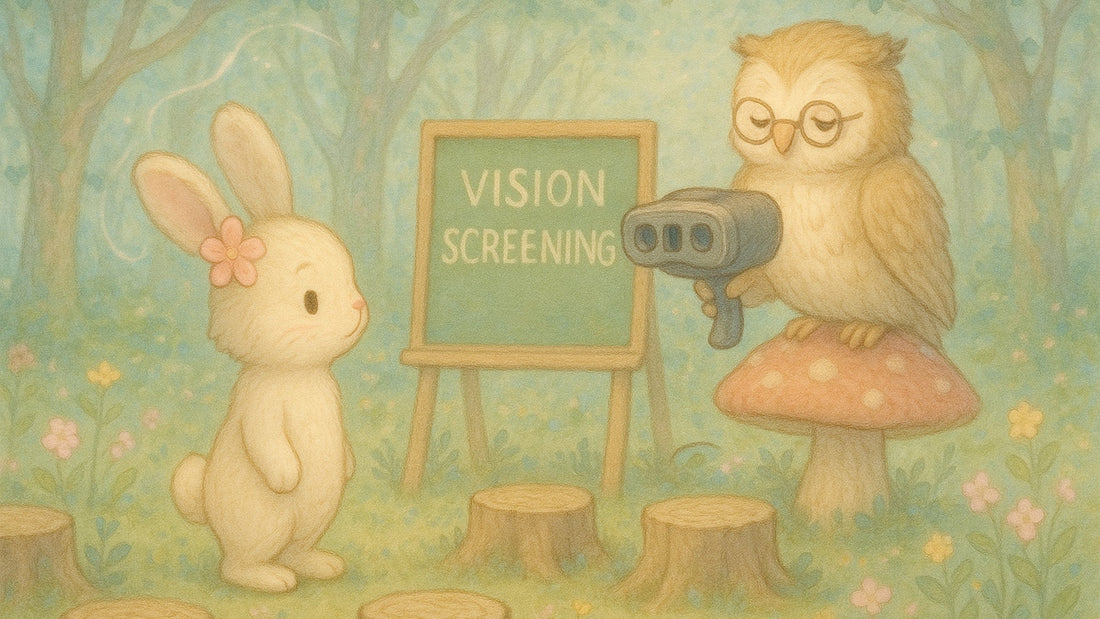
Why School Vision Screenings Aren’t Enough
Share
Author: Hayley Martin
Once upon a classroom, a child took part in a quick check on her eyes. She looked into a vision screening tool and a few seconds later the screener smiled and said, "all done". And just like that, it was assumed her vision was just fine.
But sometimes, the most important parts of the story are the ones we can’t see.
While school vision screenings serve a helpful purpose, they are but a brief glimpse, just the book cover, of a much deeper tale. To truly understand how a child sees her world, we must look beyond acuity and into the wonder of her developing eyes.

What a School Vision Screening Really Tells Us
In most schools, children are given a quick vision test once a year. These screenings check how clearly they can see faraway letters, usually on a wall chart from about 20 feet away. Alternatively, an autorefractor / photo screener might be used to estimate a child’s refractive error to determine if they might be nearsighted, farsighted or have astigmatism.
That’s it. Just one small moment, testing just one part of the visual story.
These screenings do not check:
- How well the eyes work together like a team
- How eyes track across a page while reading
- How quickly they shift focus from near to far
- Depth perception
- Peripheral vision
- The health and development of the eyes themselves
So even if a child “passes” the school screening, they may still silently struggle with reading, attention, headaches, or a mysterious dislike of schoolwork. The truth is that a school screening can miss much more than it finds. According to the American Optometric Association, 75% of school vision screenings miss vision problems.
We are not advocating to do away with the vision screenings at school as they do catch some vision issues. However, we are suggesting that the vision screening should not be solely relied on and that children need a comprehensive eye exam.
What Happens at a Comprehensive Eye Exam for Children
A visit to a pediatric optometrist is like stepping into a gentle forest of discovery, where every test reveals something new about how your child sees and experiences the world.
A full children’s eye exam typically includes:
Visual Acuity. Near and Far
Not just distant letters on a chart, but also how clearly your child sees up close (like reading a book or drawing a fairy house).
Eye Teaming and Tracking
Are both eyes dancing together, like two birds in flight? Or is one falling behind? This testing ensures both eyes work as a team while reading and learning.
Focusing & Visual Flexibility
Can your child’s eyes shift their gaze with ease? Can they shift seamlessly between the chalkboard to a notebook, from the stars in the sky to the words on a page? This is often where hidden struggles are found.
Visual Processing
The exams peek at how the brain interprets visual information, a helpful piece of the puzzle for children who struggle with reading or attention.
Eye Health
With soft lights and special tools, the optometrist gently checks inside the eyes to make sure everything is healthy and developing just as it should.

Why a “Pass” Isn’t the Whole Picture
Many parents are surprised to learn that children with vision issues often pass school screenings.
A child might see the blackboard clearly but struggle with the small print of a book. Or they might have perfect distance vision but tire quickly when reading. These issues, often missed in school, can quietly shape a child’s learning, confidence, and self-image.
A child may not say they can’t see. Instead, they say:
- “Reading is boring.”
- “School gives me a headache.”
- “I don’t like books.”
But perhaps they don’t dislike reading, they just can’t see the words clearly. To learn more about how vision problems can impact reading, refer to our When Words Start to Wiggle: How Vision Issues Can Look Like Reading Struggles article.
The Gentle Power of Early Detection
Much like catching fireflies before dusk, the earlier we find a vision issue, the easier it is to gently guide it back on track.
A yearly eye exam can help prevent vision-related learning struggles and ensure that a child’s self-confidence blossoms right alongside her curiosity.
It’s not just about eyesight. It’s about her sense of self, her joy in learning, and the spark in her eyes when she realizes she can do it.

A Clear View of Her Story
At Once Upon a Charm, we believe every little girl should see her world clearly, so she can chase butterflies, build fairy houses, and read her favorite stories without frustration.
A school screening may glance at her vision, but a full optometry exam by a pediatric or developmental optometrist opens the whole story. It will reveal how she sees, how she learns, and how she grows into her magic.
If you’d like tips on how to prepare your child for a vision exam, explore our Through Her Eyes: How to Prepare Your Child for a Pediatric Eye Exam article.
Ready to Help Her See Clearly and Sparkle Brightly?
When it’s time for glasses, invite her to choose a pair that feels like part of her fairy tale.
Our collection is designed to be as whimsical and wonderful as the girls who wear them.
We invite you to explore our glasses for little dreamers as well as our enchanting charms, beautiful and sparkly as the girls who wear them.
Once Upon a Charm. Because vision care shouldn’t just be clinical, it should be magical.
